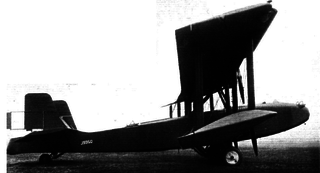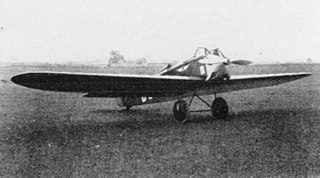Related Research Articles

The Focke-Wulf Fw 44 Stieglitz ("Goldfinch") is a 1930s German two-seat biplane. An early design by Kurt Tank, it was produced by the Focke-Wulf company as a pilot training and sports flying aircraft. It was also eventually built under license in several other countries.

The Dornier Do 11 was a German heavy bomber, developed in secret in the early 1930s. It was originally called the Dornier F before being renamed by the Reichsluftfahrtministerium (RLM) in 1933, and was considered a heavy bomber at the time. It came into service in 1932, a continuation of a line of bomber designs from the Dornier Do P in 1930, and the Dornier Do Y in 1931. The line would continue to develop with the Dornier Do 13 and Dornier Do 23.

The Siemens-Halske Sh 14 was a seven-cylinder air-cooled radial engine for aircraft produced in Germany in the 1920s and 1930s. First run in 1928, it was rated at 93 kW (125 hp).

The Arado S I was a biplane trainer built in Germany in 1925. The first of three prototypes was powered by a Bristol Lucifer radial engine, while the other two Arado S.Ia aircraft were fitted with the Siemens-Halske Sh 12. The Siemens-Halske Sh 11 powered the Arado S III, a virtually identical aircraft of which only a single prototype was constructed and sold to Turkey.

The Udet U 12 Flamingo was an aerobatic sports plane and trainer aircraft developed in Germany in the mid-1920s.

The ICAR 36 / ICAR Comercial (sic), variously also known as the ICAR M 36, Messerschmitt M 36 or BFW M.36, was a Messerschmitt design built and tested by the Romanian company ICAR in the mid-1930s. It was a small, single-engine high-wing airliner, the first civil transport aircraft built in Romania.

The Bayerische Flugzeugwerke M 18, was an airliner, produced in Germany in the late 1920s.

The BFW M.23, sometimes known as the Messerschmitt M 23, was a 1920s two-seat sporting aircraft designed by Willy Messerschmitt, and produced by Bayerische Flugzeugwerke (BFW). Examples won several prestigious races in 1929 and 1930.

The BFW M.35, sometimes known as the Messerschmitt M 35, was a German sports plane of the early 1930s. It was the last of a line designed by Willy Messerschmitt.

The BFW M.27, sometimes known as the Messerschmitt M.27, was a German two-seat sports plane with a low, cantilever wing, open cockpits and a fixed undercarriage sold in small numbers at the start of the 1930s.

The BFW M.31, sometimes known as the Messerschmitt M.27, was a radial-engined German two-seat sports plane from 1932, with a low, cantilever wing, open cockpits and fixed undercarriage. Only one was built.
The BFW M.29 was a single-engine two-seat low-wing aircraft, designed by Willy Messerschmitt for the 1932 Circuit of Europe races.

The Henschel Hs 122 was a German army cooperation/reconnaissance aircraft of the mid-1930s, radial-engined and with a parasol wing. Though only pre-production variants entered service, the Hs 122 led on to the Hs 126 which was produced in large numbers.

The BFW M.21 was a single-engined biplane trainer designed by Willy Messerschmitt for the German Ministry of Transport. It was one of only two biplanes Messerschmitt designed, neither reaching production.
The BFW M.26 was a single-engined cantilever-winged monoplane light airliner built in Germany in 1930. There were no sales and only one was built.

The sole Boulton & Paul P.32 was a British three-engined biplane built to an Air Ministry specification for a long range night bomber. A lack of engine availability slowed construction and by the time it went for tests the thinking on bomber types had moved on.

The Dietrich DP.II Bussard was a 1920s German two-seat training biplane designed by Richard Dietrich and built by the Dietrich-Gobiet Flugzeugwerke as Kassel.

The Albatros L.71 was a two-seat, single pusher engined biplane built in Germany in the 1920s.

The Udet U 1 was the first of a line of small, low-powered, low wing, cantilever monoplanes built in Germany in the early 1920s.

The Raab-Katzenstein KL.1 Schwalbe (Swallow) was a German two-seat biplane produced in the 1920s. About fifty were built and the type became well known as an aerobatic aircraft, performing at many displays in the hands of pilots like Gerhard Fieseler.
References
- Notes
- ↑ Smith 1971 , p. 9
- 1 2 3 4 Smith 1971 , p. 22
- ↑ Smith 1971 , p. 142
- Bibliography
- Smith, J Richard (1971). Messerschmitt an aircraft album. London: Ian Allan. ISBN 0-7110-0224-X.